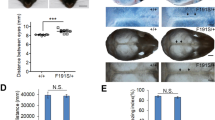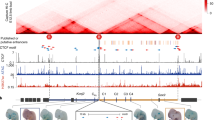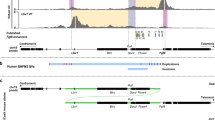Abstract
Autosomal dominant mutations in the gene encoding the basic helix-loop-helix transcription factor Twist1 are associated with limb and craniofacial defects in humans with Saethre-Chotzen syndrome. The molecular mechanism underlying these phenotypes is poorly understood. We show that ectopic expression of the related basic helix-loop-helix factor Hand2 phenocopies Twist1 loss of function in the limb and that the two factors have a gene dosage–dependent antagonistic interaction. Dimerization partner choice by Twist1 and Hand2 can be modulated by protein kinase A– and protein phosphatase 2A–regulated phosphorylation of conserved helix I residues. Notably, multiple Twist1 mutations associated with Saethre-Chotzen syndrome alter protein kinase A–mediated phosphorylation of Twist1, suggesting that misregulation of Twist1 dimerization through either stoichiometric or post-translational mechanisms underlies phenotypes of individuals with Saethre-Chotzen syndrome.
This is a preview of subscription content, access via your institution
Access options
Subscribe to this journal
Receive 12 print issues and online access
$209.00 per year
only $17.42 per issue
Buy this article
- Purchase on Springer Link
- Instant access to full article PDF
Prices may be subject to local taxes which are calculated during checkout







Similar content being viewed by others
References
Castanon, I. & Baylies, M.K. A Twist in fate: evolutionary comparison of Twist structure and function. Gene 287, 11–22 (2002).
O'Rourke, M.P. & Tam, P.P. Twist functions in mouse development. Int. J. Dev. Biol. 46, 401–413 (2002).
Firulli, A.B. A HANDful of questions: the molecular biology of the heart and neural crest derivatives (HAND)-subclass of basic helix-loop-helix transcription factors. Gene 312, 27–40 (2003).
Chen, Z.F. & Behringer, R.R. Twist is required in head mesenchyme for cranial neural tube morphogenesis. Genes Dev. 9, 686–699 (1995).
O'Rourke, M.P., Soo, K., Behringer, R.R., Hui, C.C. & Tam, P.P. Twist plays an essential role in FGF and SHH signal transduction during mouse limb development. Dev. Biol. 248, 143–156 (2002).
Tavares, A.T., Izpisua-Belmonte, J.C. & Rodriguez-Leon, J. Developmental expression of chick twist and its regulation during limb patterning. Int. J. Dev. Biol. 45, 707–713 (2001).
Wolf, C. et al. The M-twist gene of Mus is expressed in subsets of mesodermal cells and is closely related to the Xenopus X-twi and the Drosophila twist genes. Dev. Biol. 143, 363–373 (1991).
el Ghouzzi, V. et al. Mutations of the TWIST gene in the Saethre-Chotzen syndrome. Nat. Genet. 15, 42–46 (1997).
Bourgeois, P. et al. The variable expressivity and incomplete penetrance of the twist-null heterozygous mouse phenotype resemble those of human Saethre-Chotzen syndrome. Hum. Mol. Genet. 7, 945–957 (1998).
Gripp, K.W., Zackai, E.H. & Stolle, C.A. Mutations in the human TWIST gene. Hum. Mutat. 15, 150–155 (2000).
Howard, T.D. et al. Mutations in TWIST, a basic helix-loop-helix transcription factor, in Saethre-Chotzen syndrome. Nat. Genet. 15, 36–41 (1997).
Jabs, E.W. TWIST and Saethre-Chotzen Syndrome. in Inborn Errors of Development: The Molecular Basis of Clinical Disorders of Morphogenesis (ed. Epstein, C.J., Erickson, R.P. and Wynshaw-Boris, A.) 401–409 (Oxford University Press, Oxford, 2004).
El Ghouzzi, V. et al. Mutations in the basic domain and the loop-helix II junction of TWIST abolish DNA binding in Saethre-Chotzen syndrome. FEBS Lett. 492, 112–118 (2001).
El Ghouzzi, V. et al. Saethre-Chotzen mutations cause TWIST protein degradation or impaired nuclear location. Hum. Mol. Genet. 9, 813–819 (2000).
Charite, J., McFadden, D.G. & Olson, E.N. The bHLH transcription factor dHAND controls Sonic hedgehog expression and establishment of the zone of polarizing activity during limb development. Development 127, 2461–2470 (2000).
Fernandez-Teran, M. et al. Role of dHAND in the anterior-posterior polarization of the limb bud: implications for the Sonic hedgehog pathway. Development 127, 2133–2142 (2000).
Yelon, D. et al. The bHLH transcription factor hand2 plays parallel roles in zebrafish heart and pectoral fin development. Development 127, 2573–2582 (2000).
Massari, M.E. & Murre, C. Helix-loop-helix proteins: regulators of transcription in eucaryotic organisms. Mol. Cell. Biol. 20, 429–440 (2000).
Firulli, B.A., Hadzic, D.B., McDaid, J.R. & Firulli, A.B. The basic helix-loop-helix transcription factors dHAND and eHAND exhibit dimerization characteristics that suggest complex regulation of function. J. Biol. Chem. 275, 33567–33573 (2000).
Firulli, B.A. et al. PKA, PKC, and the protein phosphatase 2A influence HAND factor function: a mechanism for tissue-specific transcriptional regulation. Mol. Cell 12, 1225–1237 (2003).
Castanon, I., Von Stetina, S., Kass, J. & Baylies, M.K. Dimerization partners determine the activity of the Twist bHLH protein during Drosophila mesoderm development. Development 128, 3145–3159 (2001).
Johnson, D. et al. A comprehensive screen for TWIST mutations in patients with craniosynostosis identifies a new microdeletion syndrome of chromosome band 7p21.1. Am. J. Hum. Genet. 63, 1282–1293 (1998).
Kasparcova, V.S. et al. Molecular analysis of patients with Saethre-Chotzen syndrome: novel mutations and polymorphisms in the TWIST gene. Am. J. Hum. Genet. Suppl. 63, A367 (1998).
Corsi, A.K., Brodigan, T.M., Jorgensen, E.M. & Krause, M. Characterization of a dominant negative C. elegans Twist mutant protein with implications for human Saethre-Chotzen syndrome. Development 129, 2761–2772 (2002).
Centonze, V.E., Sun, M., Masuda, A., Gerritsen, H. & Herman, B. Fluorescence resonance energy transfer imaging microscopy. Methods Enzymol. 360, 542–560 (2003).
Hamburger, V. & Hamilton, H.L. A series of normal stages in the development of the chick embryo. J. Exp. Morph. 88, 49–92 (1951).
Yang, Y. et al. Relationship between dose, distance and time in Sonic Hedgehog-mediated regulation of anteroposterior polarity in the chick limb. Development 124, 4393–4404 (1997).
Tickle, C. The number of polarizing region cells required to specify additional digits in the developing chick wing. Nature 289, 295–298 (1981).
Olson, E.N. Regulation of muscle transcription by the MyoD family. The heart of the matter. Circ. Res. 72, 1–6 (1993).
Hamamori, Y., Wu, H.Y., Sartorelli, V. & Kedes, L. The basic domain of myogenic basic helix-loop-helix (bHLH) proteins is the novel target for direct inhibition by another bHLH protein, Twist. Mol. Cell. Biol. 17, 6563–6573 (1997).
Spicer, D.B., Rhee, J., Cheung, W.L. & Lassar, A.B. Inhibition of myogenic bHLH and MEF2 transcription factors by the bHLH protein Twist. Science 272, 1476–1480 (1996).
McFadden, D.G., McAnally, J., Richardson, J.A., Charite, J. & Olson, E.N. Misexpression of dHAND induces ectopic digits in the developing limb bud in the absence of direct DNA binding. Development 129, 3077–3088 (2002).
Zuniga, A., Quillet, R., Perrin-Schmitt, F. & Zeller, R. Mouse Twist is required for fibroblast growth factor-mediated epithelial-mesenchymal signalling and cell survival during limb morphogenesis. Mech. Dev. 114, 51–59 (2002).
Bialek, P. et al. A twist code determines the onset of osteoblast differentiation. Dev. Cell 6, 423–435 (2004).
Yoshida, C.A. et al. Runx2 and Runx3 are essential for chondrocyte maturation, and Runx2 regulates limb growth through induction of Indian hedgehog. Genes Dev. 18, 952–963 (2004).
Otto, F. et al. Cbfa1, a candidate gene for cleidocranial dysplasia syndrome, is essential for osteoblast differentiation and bone development. Cell 89, 765–771 (1997).
Okuda, T., van Deursen, J., Hiebert, S.W., Grosveld, G. & Downing, J.R. AML1, the target of multiple chromosomal translocations in human leukemia, is essential for normal fetal liver hematopoiesis. Cell 84, 321–330 (1996).
Komori, T. et al. Targeted disruption of Cbfa1 results in a complete lack of bone formation owing to maturational arrest of osteoblasts. Cell 89, 755–764 (1997).
Logan, M. & Tabin, C. Targeted gene misexpression in chick limb buds using avian replication-competent retroviruses. Methods 14, 407–420 (1998).
Laufer, E. et al. Expression of Radical fringe in limb-bud ectoderm regulates apical ectodermal ridge formation. Nature 386, 366–373 (1997).
Srivastava, D. et al. Regulation of cardiac mesodermal and neural crest development by the bHLH transcription factor, dHAND. Nat. Genet. 16, 154–160 (1997).
Srivastava, D., Cserjesi, P. & Olson, E.N. A subclass of bHLH proteins required for cardiac morphogenesis. Science 270, 1995–1999 (1995).
Pathi, S. et al. Comparative biological responses to human Sonic, Indian, and Desert hedgehog. Mech. Dev. 106, 107–117 (2001).
Kaufman, M. The Atlas of Mouse Development (Academic, San Diego, 1992).
Acknowledgements
We thank K. Dionne and I. Messina for technical assistance; S. Weiner for help with in situ analyses; and L. Field, C. Tabin, T. Jessell, A. Kania, D. Vasiliauskas, L. Zeltser and members of the laboratory of E.L. for comments on the manuscript. This work was supported by the National Institutes of Health (to A.B.F., D.M.V. and D.K.), March of Dimes Birth Defects Foundation (to A.B.F.), American Cancer Society (to P.C.), American Heart Association (to P.C.) and Howard Hughes Medical Institute Research Resources Program for Medical Schools (to E.L.).
Author information
Authors and Affiliations
Corresponding authors
Ethics declarations
Competing interests
The authors declare no competing financial interests.
Rights and permissions
About this article
Cite this article
Firulli, B., Krawchuk, D., Centonze, V. et al. Altered Twist1 and Hand2 dimerization is associated with Saethre-Chotzen syndrome and limb abnormalities. Nat Genet 37, 373–381 (2005). https://doi.org/10.1038/ng1525
Received:
Accepted:
Published:
Issue Date:
DOI: https://doi.org/10.1038/ng1525
This article is cited by
-
A spatio-temporally constrained gene regulatory network directed by PBX1/2 acquires limb patterning specificity via HAND2
Nature Communications (2023)
-
A single-cell transcriptome atlas profiles early organogenesis in human embryos
Nature Cell Biology (2023)
-
USP13 promotes breast cancer metastasis through FBXL14-induced Twist1 ubiquitination
Cellular Oncology (2023)
-
Polycomb Repressive Complex 2: a Dimmer Switch of Gene Regulation in Calvarial Bone Development
Current Osteoporosis Reports (2020)
-
Partially Penetrant Cardiac Neural Crest Defects in Hand1 Phosphomutant Mice: Dimer Choice That Is Not So Critical
Pediatric Cardiology (2019)



